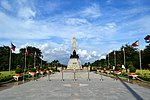Plaza Moriones
Originally an open green field lined with benches in colonial times, today the plaza is paved, with a size of 2,227 square meters (23,970 sq ft) and a capacity of 6,681 persons. Trees and benches line its entire length, and three fountains have been placed throughout the plaza. Flanked by paved roads, the central portion of the plaza resembles 19th century garden design with its plants such as bandera española (canna) flowers and palm trees. At the end of the plaza stands the Sigaw ng Tondo, a monument sculpted in 1978 by Eduardo Castrillo in memory of local victims fleeing Japanese forces during the Battle of Manila in 1945. In 2010, another monument was erected at the plaza in memory of Honorio Lopez, a Tondo-born playwright who fought in the Philippine Revolution. This monument was designed by Toym Imao.
Owing to its location in Tondo, a working-class area of Manila, Plaza Moriones serves as a center for Philippine political discourse, second only to Plaza Miranda in Quiapo in terms of importance. On May 1, 1903, thousands of members of the Unión Obrera Democrática Filipina, led by Isabelo de los Reyes, organized the Philippines' first Labor Day celebrations, with laborers such as tailors, mechanics, barbers and lithographers marching from the plaza to Malacañang Palace. Several years later, the Partido Komunista ng Pilipinas (PKP) was established on November 7, 1930 at a public rally held at the plaza, attended by six thousand people. Currently, Plaza Moriones is designated as one of five freedom parks in the City of Manila, where protests and rallies may be held without requiring permission from local authorities.
Beyond politics, Plaza Moriones is also significant for its location close to the Port of Manila: in 1906, the first nuns of the Order of Saint Benedict assigned to the Philippines arrived from Germany, landing at the plaza.
References
- ^ Aben, Elena L.; Antonio, Raymund F. (May 7, 2006). "Metro's freedom parks: Where people can unwind, unload ire". Manila Bulletin. Manila Bulletin Publishing Corporation. Metro Manila Bulletin, pp. 2–3.
- ^ Intramuros, in and around: An Interactive Guide. Jesuit Communications Foundation, Inc. 2003.
- ^ "Tondo". The Manila Times. Manila Times Publishing Corporation. February 29, 2004. p. A6.
- ^ Lazaro, Freddie G. (May 2, 2006). "Vigan City officials, employees honor Don Belong, father of RP labor union". Manila Bulletin. Manila Bulletin Publishing Corporation. Retrieved July 1, 2013.
- ^ "The Situation of the Philippine Trade Union Movement" (PDF). Fighting Back with Social Movement Unionism. Alliance of Progressive Labor. Archived from the original (PDF) on July 21, 2012. Retrieved July 1, 2013.
- ^ Partido Komunista ng Pilipinas-1930 (October 6, 2005). "The Philippines: The Philippine Communist Party (PKP) To Celebrate 75th Year". Political Affairs. Retrieved July 1, 2013.
{{cite web}}: CS1 maint: numeric names: authors list (link) - ^ Pomeroy, William J. (1992). The Philippines: Colonialism, Collaboration, and Resistance. International Publishers. p. 72. ISBN 0-7178-0692-8.
- ^ "St. Scholastica's College Timeline: 1990-1999". St. Scholastica's College Manila. Retrieved July 1, 2013.
